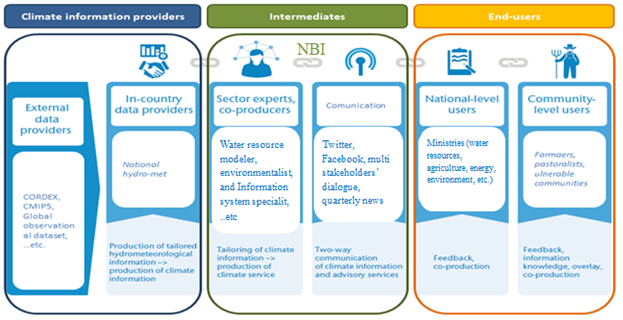
The effects of climate change are being felt around the globe. The African continent, while contributing least to greenhouse gas emissions, is most vulnerable and yet is predicted to be hit hardest by the impacts of climate change.
These have the potential to undermine development and even undo progress made to date. Rising temperatures and changed rainfall patterns are expected to increase climate variability and both the number and intensity of extreme weather events such as heat waves, droughts, storms, and floods, resulting in water contamination, vector-borne diseases and food shortages.
As climate change also becomes an acutely felt reality in the Nile Basin, countries require the data, knowledge and capacity to deal with its effects on the ground. NBI acts as an intermediate Climate Service provider for hydrological issues at the regional level in order to enable countries to forecast and adapt to climate change in the Nile Basin effectively.
The NBI Climate Change Strategy establishes a strategic implementation framework for the integration of climate change aspects in basin management with the overall goal of strengthening basin-wide resilience to climate change and ensure climate compatible water resource management and development.
Amongst the services NBI provides to its member countries are hydrological and meteorological products, climate change and hydrological scenario products, tailored hydrological modelling and forecasting products, Decision-Support tools, Climate Service communication ...
NBI Climate Services Catalogue
Amongst the services NBI provides to its member countries are hydrological and meteorological products, climate change and hydrological scenario products, tailored hydrological modelling and forecasting products, Decision-Support tools, Climate Service communication & outreach products and user support & training products. The NBI Climate Services Catalogue provides an overview of all current and planned services under NBI.
With this guideline, you can develop an understanding of the rationale of climate proofing, familiarise yourself with the key concepts of climate-proofing, climate risk and climate risk management, as well as take a deep dive into the step-by-step procedure of climat...
Climate Proofing Guidance
With this guideline, you can develop an understanding of the rationale of climate proofing, familiarise yourself with the key concepts of climate-proofing, climate risk and climate risk management, as well as take a deep dive into the step-by-step procedure of climate-proofing of infrastructure investments and different stages of its lifecycle, from policy to project identification, preparation etc. The guidelines are enriched with links to internal and external resources, case studies, a glossary and references. They are available in PDF and interactive formats.
The NBI Climate Proofing E-Learning Course introduces instruments and methodologies for the climate proofing of infrastructure investments along the investment cycle. The course offers guidance on overcoming governance challenges for climate change and covers themes ...
NBI Climate Proofing E-Learning Course
The NBI Climate Proofing E-Learning Course introduces instruments and methodologies for the climate proofing of infrastructure investments along the investment cycle. The course offers guidance on overcoming governance challenges for climate change and covers themes from policy formulation to project identification, preparation, resource mobilisation, construction and the operation and maintenance of new and existing infrastructure.
The PIEVC Practitioners' Network facilitates engagement across a multitude of stakeholders and practitioners, internationally and within Canada, who are working to enhance the resiliency of infrastructure projects to the impacts of climate change. Membership to this ...
User Community
The PIEVC Practitioners' Network facilitates engagement across a multitude of stakeholders and practitioners, internationally and within Canada, who are working to enhance the resiliency of infrastructure projects to the impacts of climate change. Membership to this group is open to anyone with an interest in climate change vulnerability and risk assessments (CCVRA) for infrastructure and we strive to offer a variety of options to participate in this network to build your practice and share your expertise and lessons learned with other practitioners. This includes offering ideas for webinars or global forum topics, sharing resources, asking or responding to questions to help move the field of CCVRA forward, and discussing barriers and finding solutions.
Observation and Monitoring comprises of networks and systems used for the collection, sharing and delivery of climate monitoring data and information from National Hydrological and Meteorological Services (NHMS) on e.g. hydro-meteorological and climate change etc. Th...
Observations & Monitoring
Observation and Monitoring comprises of networks and systems used for the collection, sharing and delivery of climate monitoring data and information from National Hydrological and Meteorological Services (NHMS) on e.g. hydro-meteorological and climate change etc. The data and information are used to support further processing and development of products and services to support water resources management in the basin.
Climate impact modelling, projections and scenarios are used to project future applies to changes in mean values of key climate variables, as well as their impacts on soil and water resources. It can also be used on changes in frequency and magnitude of extreme event...
Climate Impact Modelling & Projections
Climate impact modelling, projections and scenarios are used to project future applies to changes in mean values of key climate variables, as well as their impacts on soil and water resources. It can also be used on changes in frequency and magnitude of extreme events such as droughts, floods and river flows dynamics as well as their implications for, and other sectors in the Basin. The data and information products can be used for any purpose for adaptation of water resource management practices, agriculture, energy, and infrastructure investments in the Nile Basin.

